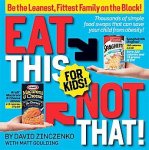 Feb. 22, 2009 It’s Sunday, and I rarely post on the weekend, but I have to say, I’m having a book for brunch, digesting and devouring the Eat This, Not That! For Kids by David Zinczenko with Matt Goulding of Men’s Health.
Feb. 22, 2009 It’s Sunday, and I rarely post on the weekend, but I have to say, I’m having a book for brunch, digesting and devouring the Eat This, Not That! For Kids by David Zinczenko with Matt Goulding of Men’s Health.
Eat This, Not That pulls kid-friendly fare off the menus of “sit down” restaurants (which make up one-quarter of our meals but account for more than one-third of our calories) and give the ‘lesser of two evils’ in many cases, in ‘better for you’ comparative analysis.
Granted, they cover a gazillion food brands and chain restaurants I wouldn’t choose to begin with…But the point is, kids do. No matter WHAT they tell you. So before you set out for those IHOP pancakes, or drive to Denny’s for your free Grand Slam breakfast they’ve been plugging lately, you might want to pop this book in the glove box.
I happen to be craving IHOP’s “silver dollar pancakes” right now (and they serve 83,000 pancakes EVERY DAY of the year, so evidently I’m not alone). So…this book fills you in a bit. What to know before you go?
IHOP scored an automatic “F” for not providing nutritional data, but it wasn’t on their 20 Worst Kids’ Foods in America list…
In fact, IHOP’s Kids’ Silver Five merited their thumbs up ‘eat this’ for ‘only’ having 10g fat, 415mg sodium, 480 cals, whereas the ‘not that’ was IHOP’s Kids’ Cheese Omelet with 40g fat, 1,175mg sodium, 790 cals…(woohoo, lucky me!) And…
Who would’ve thought that IHOP’s Kids’ Chocolate Chip Pancakes (ewww!) were ‘better for you’ than their Harvest Grain ‘N Nut Pancakes? (15 g fat, 680 mg sodium vs. 36g fat/18g sat fat; 1240mg sodium respectively)
Talk about reading between the lines of label lingo!
It’s all relative, since most of this stuff is ‘once in awhile’ fare to begin with, but I guess that’s why I find this book so useful and appealing…
You can visually get a snapshot of the best and the worst if you’re navigating the kids’ menu minefields of vending machines, juices, snack packs and cafeteria crud. Our teen teams alone were wide-eyed and slack-jawed at some of the surprises…
“Say WHAT? You’re tellin’ me that all-natural organic yogurt had more sugar than your ice-cream bar? How can that BE?”
It’s definitely in no way a cheat sheet guide for health, as many of their ‘eat this’ selections would make our Shaping Youth nutrition guru RD Rebecca Scritchfield roll her eyes…
But that’s precisely why I bought it…
…To get up to speed on brand-name biggies and some of the food giant snack packs we see in the school trash when we do our ‘dumpster dive’ analysis of what kids are REALLY eating (vs. what kids SAY they’re eating) when we assess the hot buttons in each given region for our Dare to Compare, Gross Out Game for Good Nutrition.
I’m always on the prowl for fun finds and great deconstruction platforms to demo weasel words and critical thinking strategies. (e.g. I use CSPI’s Nutrition Action Newsletter,RDs, nutritionists, Yale’s Rudd Center for Food Policy & Obesity, the UCB Wellness Letter, etc.)
Eat This, Not That for Kids uses callouts and colors in a picture book style of appealing factoids that can make it fun to skim the food myths, sugar spikes, guilty pleasure picks and brand by brand comparisons.
But it’s NOT a book for those who swallow their media whole, OR for kids who pick it up, thumb through a few pages and declare it as ‘fact’ just because it was on the ‘eat this’ page.
I’ve purposely ‘left the book out’ on the table in my own little ‘focus groups’ to see how kids would read/react to it…
More often than not, kids browse the book with interest, lob a few ‘whoas’ and ‘wows’ and ‘check this out’ exclamations in the air and then emphatically cling to the printed word as “carte blanche approval” to eat some of this crud…
 That said, it definitely does much more than scrape the surface, and their choices have given me plenty to chew on in terms of how I go about positioning some of the common content in our own work.
That said, it definitely does much more than scrape the surface, and their choices have given me plenty to chew on in terms of how I go about positioning some of the common content in our own work.
This book details a slew of name-brand picks and pans that we KNOW kids are consuming but we counter-market by category. (e.g. sports/energy drinks which we deconstruct for sodium/sugar content etc. as shown below, or sat fat in ethnic foods where we swap out leaner versions, etc.)
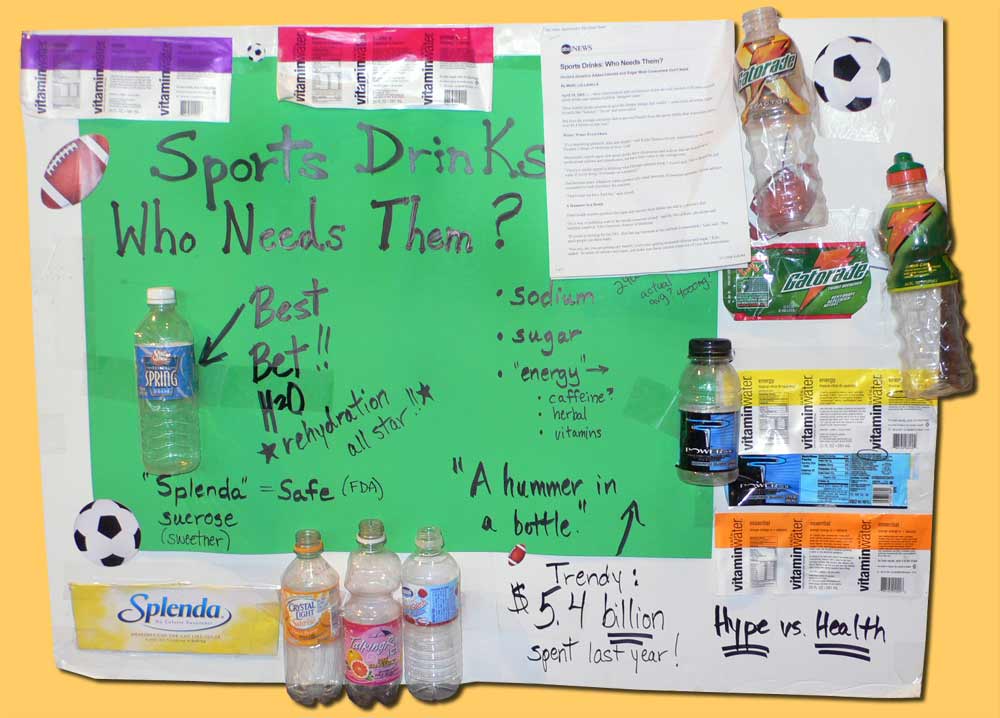
For MY purposes, Eat This, Not That is basically a branded variation of our nonprofit’s ‘switch pitch’ that we use in our Dare to Compare Gross Out Games for Good Nutrition, where we show swap-outs and choices that are better than others by nutrient, more than by brand…
Example? In their “drink this, not that’ section, they have Dasani Water obviously in the ‘drink this’ category, (0 cals/fat/sugar) and in the ‘not that’ category, 20 oz. of Glaceau Vitamin Water (125 cals, 33g sugars) rightfully claiming that this ‘functional beverage’ carries nearly as much sugar as a can of Coke…
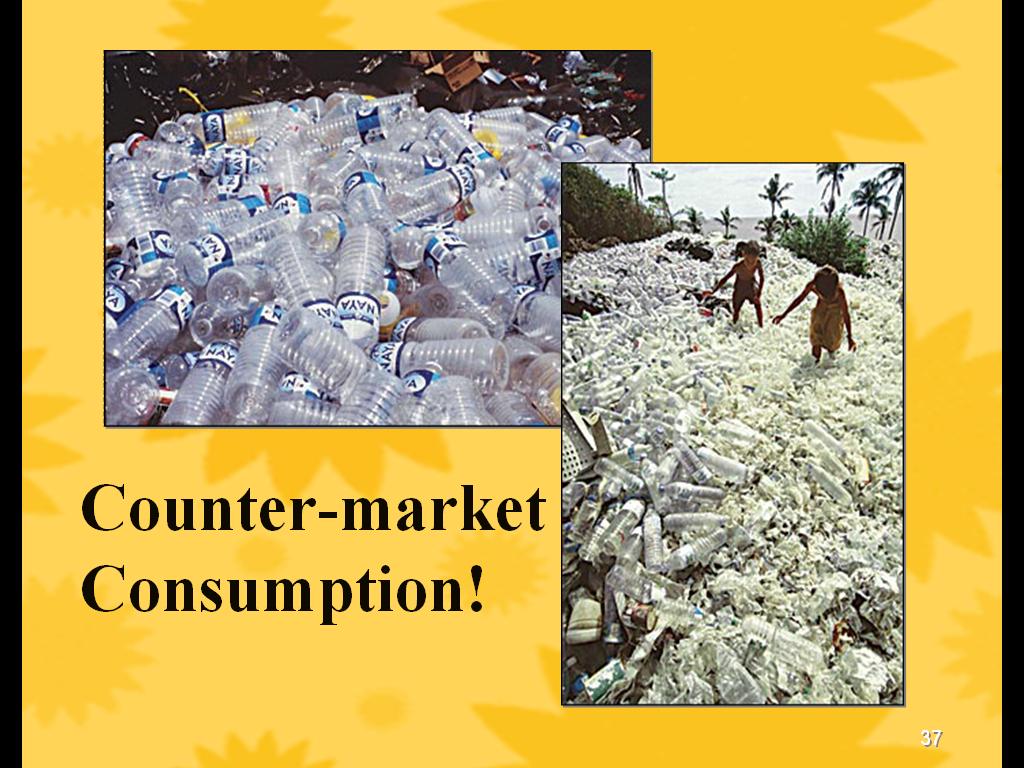 Whereas at Shaping Youth, we counter-market the whole concept of buying bottled water itself!
Whereas at Shaping Youth, we counter-market the whole concept of buying bottled water itself!
We ask kids to generate their own brand name, taglines, nutrient claims, and ‘why to buys’ for their water and think about how things are ‘sold’ in their neighborhood, deconstructing the whole process from manufacturing and distribution to marketing/sales and sustainability issues with planetary waste.
But that’s another story…And I’m getting hungry.
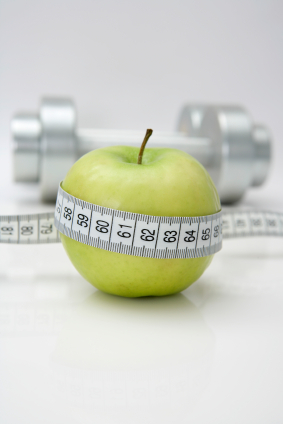 It’s too rainy to trek to IHOP (ok, not healthy anyway) and “don’t skip breakfast” is one of the books’ biggies for kids…We constantly remind kids about it too, since it fouls ups kids’ body works the same way that not getting enough sleep does.
It’s too rainy to trek to IHOP (ok, not healthy anyway) and “don’t skip breakfast” is one of the books’ biggies for kids…We constantly remind kids about it too, since it fouls ups kids’ body works the same way that not getting enough sleep does.
(ahem. Yes, mom, I can FEEL the burn)
Granted, it’s ‘counter-intuitive’ since many think the less you eat and the longer you’re up burning off the day, the more you’d be unlikely to put on weight, right? Wrong. Studies show breakfast eaters are about 30% LESS likely to be obese even though they eat MORE food…
Skipping breakfast actually hurts your prospects for normal body chemistry since that ol’ metabolism/body starvation theory kicks in over missed meals vs. noshing healthy tidbits keeping metabolic rate high throughout the day.
In their chapter, “Doggie Paddling Through the Nutritional Ocean” the authors noted that on a 2005 survey day synthesizing 47 studies that examined the impact of starting the day with a healthy breakfast, 8% of 1 to 7 year olds skipped, 20% of 8-10 year olds skipped, and 30% of 15-18 year olds skipped. Yowza. That’s a lot of skipping.
So, breakfast it is…Hmn…
How ‘bout an English muffin or a bagel?
Perfect case in point on the ‘visual takeaway’ vs. ‘within a brand line’ message that is watch-worthy for critical thinking skills when/if you read this packaged goods guide…Here’s what I happen to have in my fridge:
Thomas’ Hearty Grains 100% Whole Wheat Bagels AND Thomas’ Hearty Grains 100% Whole Wheat English Muffins (must’ve been on sale!?)
And here’s the nutritional breakdown:
Thomas’ HG Bagel: 240 cal, 2g fat (.5 sat fat) 7g sugars, 7g fiber
Thomas’ HG English Muffin: 130 cal, 1g/0sat fat, 2g sugars, 3g fiberLooks to me like I should be ditching bagels and goin’ for English muffins only, by that data, right? But here’s where the books’ visual context can go gonzo fast if you skim over the details…
On the ‘Eat This’ page, they had my Thomas’ HG Eng. muffin (above) AND—
Pepperidge Farm Whole Wheat Bagel: 250 cal, 1.5g fat/0 sat fat, 9g sugars, 6g fiber
Pepperidge Farm Brown Sugar Cinnamon Mini Bagels: (2) 240 cal, 1g fat/0sat fat, 12g sugars, 4g fiber
On the ‘Not That’ page:
Pepperidge Farm Plain Bagel: 260 cal, 1g fat/0 sat fat, 10g sugars, 3g fiber
Thomas’ Cinnamon Raisin Muffin: 140 cal, 1g/0sat fat, 9g sugars, 2g fiber
What about the fact that ANY of the bagels were about twice the cals as English muffins, and that ALL were high in sugars, whole wheat or not?!
What if they compared two similar FLAVORS (e.g. cinnamon) pointing to the sugar/fiber differentiation? Which would be a ‘better for you’ pick?
Pepperidge Farm Brn Sugar Mini-Bagels (2):
240 cal, 1g fat/0sat fat, 12g sugars, 4g fiber OR…
Thomas’ Cinnamon Raisin Muffin: 140 cal, 1g/0sat fat, 9g sugars, 2g fiber
(Trick question, as the book already gave their answer; scroll back)
See what I mean?
The eyes and the mind can alter the context so that everything blurs into a visual reference, which concerns me since many kids skim, and don’t READ the details. (e.g refined flour of white breads can cause blood sugar to soar, metabolic changes, yadayada)
The book has TONS of valid nutrition data…Just make sure you use the brands as a benchmark as ‘Better for You’ choices WITHIN a brand line.
It’s like those ‘smart choices made easy’ or ‘sensible snacking’ green emblems that are self-awarded by the parent company to cue naïve shoppers to what’s a ‘BFY’ buy…
Lays? Or Baked Lays? Junk in, junk out, either way…
I particularly like the author’s analysis of kids’ offerings from the major chains, since I generally ‘don’t go there’ (figuratively or literally) in our counter-marketing sessions, and I DO get asked those kinds of questions by the kids a lot.
I even signed up for their free newsletter to keep abreast of kid foods beyond my academic wonkette research style, for a quickie snapshot to drill down deeper.
Like? “Salads to toss” (um, as in out the doorway) and “14 health foods that aren’t” to compare if we’re on the same page in terms of the ‘aha moments’ that we use in our counter-marketing games with kids…
But be aware, I noticed the more I surfed the online site it tried to ‘upgrade me’ to a ‘premium’ access paygate, and began locking me out of certain pages in the browse-n-buy rev stream of lingering too long…so again, heads up.
The minute it started locking me out of pages I realized they had a sophisticated user database being built and customized to my surfing.
Thinking about the CDD and Jeff Chester’s Digital Ads.org site on interactive deployments (I’ll be speaking with him tomorrow about this and other online privacy practices) I decided to click on the site’s privacy page to see what kind of data they were collecting on my browsing habits.
Sure enough, they’re skimming a piece of the PII. (personal identifying information) I’m starting to check this when surfing any site that sells ANYthing; as data mining and e-havioral targeting is ubiquitous. (some is handy, some is heinous, it’s a matter of figuring out the trade-offs between customized content and convenience and that icky, stalker feeling of being tracked and followed with every click)
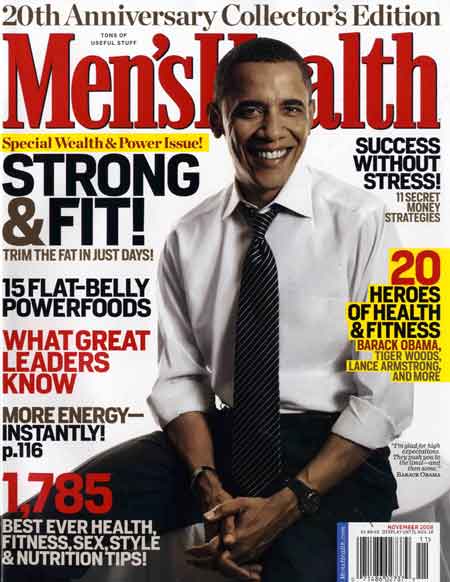 As for who’s behind this handy little book series?
As for who’s behind this handy little book series?
Global media giant, Rodale.
No, not the hair regrowth folks, that’s Rograine.
RODALE…As in publishers of health and wellness lifestyle magazines (Men’s Health, Prevention, Women’s Health, Runner’s World/Running Times, Organic Gardening, Mountain Bike, their newcomer, Best Life) diet books, website, and that kind of thing).
Makes sense they’d be a subscription based ‘buy more’ model, they’re good marketers for sure. This is my umpteenth time wading through the book on a rainy day like today, and I always find something new to tuck away…
From ’20 unhealthiest drinks in the USA’, to ‘healing’ foods that cure, Eat This, Not That for Kids is one of those books you’d hope to find in a pediatrician’s waiting room, a teacher’s lounge, or plopped in the corporate cafeteria…Definite conversation starter with kids too…Thumbs up here.
Here are a few highlighted snippets that jumped off the page at me:
I’m always being asked,
…“But what’s changed since we were kids? Isn’t it all the same aside from MORE media/marketing?”
Surely you jest. Check out our food supply. (And Michele Simon’s book Appetite for Profit)
The CDC found that kids in the USA eat more than 150 additional calories every DAY than they did 20 years ago.
Eat This, Not That for Kids capsulized ‘what’s different’ in short form:
1.) We’ve added extra calories to traditional foods. (HFCS hit the scene in the ‘70s as a cheaper, shelf-stable swapout for sugar, and it began showing up everywhere. The FDA says 82g of added sugars are consumed daily, an empty 317 calories to our diet, DAILY)
2.) We’ve been trained to supersize it. (clearly marketing complicity here going on here w/large scale profits tied to mass production/lower cost of value meals, so essentially, they point out that you’re getting 73% more calories for ‘only a 17% increase in cost)
3.) We’ve laced our food with time bombs. (the transfat issue; cheap and effective for taste and texture, but increasing bad cholesterol, lowering good cholesterol and increasing heart disease risk)
4.) We’re drinking more calories than ever. (UNC study shows we consume 450 calories a day from drinks; nearly twice as many as 30 years ago; or 23 pounds a year that need working off!)
5.) We don’t know what’s in our food. (‘new and improved’ gobbledygook includes ‘frankenfood’ substances including new types of preservatives, sweeteners and texture enhancers)
Related Resources/Reviews
WebMD has a review that includes Elizabeth Ward, RD, author of The Complete Idiot’s Guide to Feeding Your Baby and Toddler, that applauds the book overall with a few caveats: “It’s a snapshot of what most kids are eating, and while not exhaustive, parents can use the nutrition facts to learn more about the nutritional goodness of eating whole foods over processed and fast foods,” Ward says.
Ward said she had a few concerns about the “Eat This, Not That” recommendations. For example, the book lists Yobaby peach yogurt as having 13 grams of sugar per 4-ounce portion, but this number includes 6 grams of naturally occurring lactose (milk sugar). Instead, she says, the listing should specify that there are 7 grams of added sugar.
“Lumping lactose with added sugar makes foods like Yobaby peach yogurt look like it is high in sugar, which is confusing to parents and technically incorrect,” she says.
Ward also says it’s inconsistent for the authors to leave so many common processed foods out of the food pyramid, “and then promote the consumption of processed foods as the lesser of two evils throughout the book.” Ward’s own advice to parents looking to feed their kids a healthier diet: Prepare more meals at home, where you control the ingredients.”
About.com’s review: Sums that you’ll learn what to order at 40 popular restaurants, from Applebee’s to Wendy’s; compare popular foods by seeing calories, fat grams, and amount of sodium, make healthier choices at the grocery store by learning to read nutrition fact labels. And offers the pros and cons as follows:
Pros
* quick summary of nutritional causes of childhood obesity
* great advice on importance eating a variety of vegetables
* teaches parents how to read menus and nutrition facts labels
* includes a section on trying to eat healthy at school
Cons
* few suggestions on how to get your kids to eat the healthier foods
* none of the information is actually targeted at kids
* no information about food allergies
Diets in Review blog (visual credit for cereal screenshot) focused more on the grade aspects themselves noting that some of the restaurants received Fs because it’s their official policy not to publish nutrition information, claiming “that’s an entirely different rant for a different post” and I totally agree with her! (but a worthy rant it is!)
Here’s her summary of extremes:
![]() Chick-Fil-A: A (the only solid A on the list)
Chick-Fil-A: A (the only solid A on the list)
Subway: A-
Wendy’s: A-
Olive Garden: F
IHOP: F
Applebee’s: F
TGIFriday’s: F
A fair number of Bs went to KFC, McDonald’s and Panera; Cs went to Taco Bell, Burger King and Au Bon Pain; Ds earned by Chipotle, Dairy Queen and Baja Fresh.
Under the Tuscan Gun Review by a dad, foodie, epicurean, chef based in L.A., Gabriele Corcos who does Private Dinners, with actress wife Debi Mazar) who share their family fun, celebrity style via video episodes on healthy, traditional Tuscan recipes and cooking creations (my latest blogosphere culinary find!)
Ellen DeGeneres Video Review HIGHLY recommedn this 8:03 interview with author David Zinczenko involving the audience with guessing games and interchange on choices made in the book…the ‘one over the other’ comparative analysis becomes quite clear. Wish it were on YouTube so I could embed it for ya!
The Mom Crowd Another new one I found, showing how a mom really was enlightened by the book a few weeks ago; you can almost FEEL her incredulity at the absurdity of some of the food marketing. She writes, “Did you know that organic ketchup has 3X more lycopene (cancer fighting agent found in tomatoes and watermelon) in it than non-organic? I usually don’t purchase organic foods (even though I’d love to!) due to the expense but I will probably start buying organic ketchup.”
So you can see the power of media to influence the health of our future…
Here’s a video of Co-Author Matt Goulding 13:58, Food Nutrition Editor from Men’s Health via YouTube which sums some of the ‘whoa’ restaurant caloric impact by visually explaining ‘worst foods’ noting chains like Macaroni Grill, Chili’s, etc.
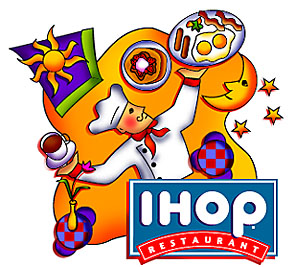
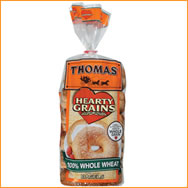









You’re makin me wanna buy this book. Hope it’s good.
Hi Sharon, yah, it’s a keeper as a teaching tool…but if we can all stay ‘closer to the land’ we’ll avoid the packaged goods stuff more altogether…Hard though when we’re duped into thinking what’s ‘healthy’ isn’t.
FROM CSPI:
“Please urge your Congressional Representative to get junk food out of schools. Despite alarming childhood obesity rates, schools still sell sugary drinks and unhealthy foods to their students. The current nutrition standards for foods sold in vending machines and a la carte lines are 30 years old and no longer make sense. They prohibit the sale of gum and seltzer water, but allow the sale of candy bars and soda.
The Child Nutrition Promotion and School Lunch Protection Act soon will be reintroduced in the House of Representatives, and would update the national nutrition standards for foods sold out of vending machines, a la carte, and other foods sold outside of school meals. Please send a letter to your Representative asking them to cosponsor this legislation (see model letter below) and get junk food out of schools.”
Take action here:
http://takeaction.cspinet.org/campaign/housenutritionstandardsbill/iwibbdbr97im3wk6?
Oh, and here’s the ‘sample letter’ they suggest, which you can adapt/adopt as you see fit:
RE: Cosponsor the Child Nutrition Promotion and School Lunch Protection Act
“As your constituent, I urge you to cosponsor the Child Nutrition Promotion and School Lunch Protection Act, sponsored by Representative Lynn Woolsey. Despite the childhood obesity epidemic, schools are still allowed to sell unhealthy food in vending machines, a la carte lines, school stores, and other venues outside of meals. The bill would update the national nutrition standards for foods sold outside of meals to help ensure that school foods are healthful.
The current national school nutrition standards are 30 years old and no longer make sense from the standpoint of science or children’s health. They prohibit the sale of seltzer water and breathe mints, but allow the sale of candy, snack cakes, and sugary drinks. Considering that children get 30-50% of their daily calorie intake at school, the sale of these foods undermines the diets and health of young people. Updating the national school nutrition standards would support parents’ ability to feed their children healthfully and reinforce nutrition education in schools. Importantly, studies show that schools can make just as much money selling healthier foods.
Please let me know if you will cosponsor the Child Nutrition Promotion and School Lunch Protection Act. I look forward to hearing from you.”
etc. etc.